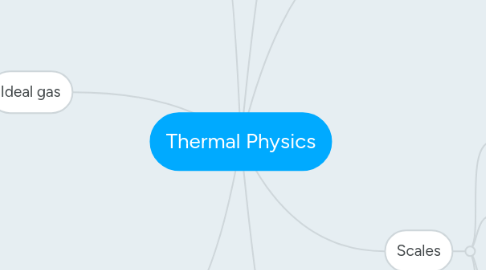
1. Laws of Thermodynamics
1.1. Zeroth Law of Thermodynamics
1.1.1. States that if objects A and B are separately in thermal equilibrium with a third object, C, then A and B are in thermal equilibrium with each other
2. Thermal expansion of solids
2.1. Definition
2.1.1. Consequences of change in average separation between its atoms or molecules
2.2. Linear expansion
2.2.1. ∆L = α•Lo•(T-To)
2.3. Area expansion
2.3.1. ΔA = Ao.2α.ΔT
2.4. Volume expansion
2.4.1. ∆V = β.Vo.∆T
3. Ideal gas
3.1. Law
3.1.1. PV=nRT
3.2. Gases at room temperature and pressure behave
3.3. Characteristics
3.3.1. Collections of atoms -moves randomly
3.3.2. No long-range force between atoms
3.3.3. Occupies negligible volume
4. Definition/Principle
4.1. Study of temperature, heat and how it affect matters
4.2. Heat?
4.2.1. Process of energy exchanged between object because of temperature changes
4.3. Thermal contact?
4.3.1. Happens when energy can be exchanged between two objects
4.4. Thermal equilibrium?
4.4.1. Happens when two objects that is in thermal contact but no net exchange of energy between them
5. Kinetic theory of gases
5.1. Gases that are particles which is constant and in random motion
5.2. Rapidly moving particles, collide with each other and with walls of container
6. Thermometers
6.1. Liquid thermometer
6.1.1. Mercury thermometer
6.1.2. Used commonly
6.1.3. Mercury expands when temperature rise (gives reading)
6.2. Gas thermometer
6.2.1. Pressure varies, with constant volume
7. Scales
7.1. Temperature/ Celcius
7.1.1. Ice-water mixture (0 celcius)
7.1.2. Steam-water mixture (100 celcius)
7.1.3. 100 divisions
7.2. Kelvin
7.2.1. Pressure=0K equivalent to Temperature+-273.15 celcius
7.3. Fahrenhait
7.3.1. Ice point = 32 F
7.3.2. Steam point = 212 F
7.3.3. 180 divisions
7.4. Conversion between scales
7.4.1. Celcius and Kelvin
7.4.1.1. Kelvin = Celsius + 273.15
7.4.2. Celcius and Fahrenheit
7.4.2.1. T(°F) = T(°C) × 9/5 + 32
7.4.3. Kelvin to Fahrenheit
7.4.3.1. ° F = 9/5(° K - 273) + 32
